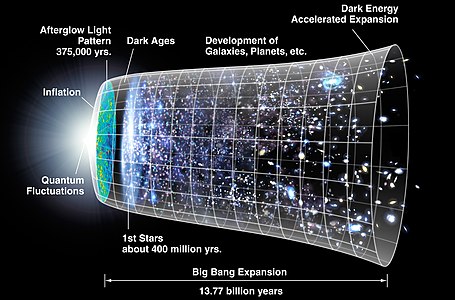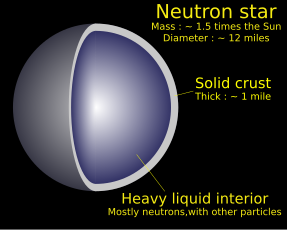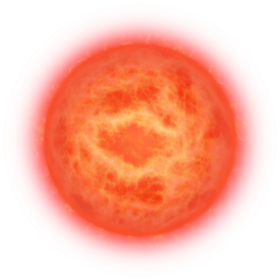User:JadenKc/sandbox
| Submission declined on 18 January 2025 by Bkissin (talk). Thank you for your submission, but the subject of this article already exists in Wikipedia. You can find it and improve it at Universe instead.
Where to get help
How to improve a draft
You can also browse Wikipedia:Featured articles and Wikipedia:Good articles to find examples of Wikipedia's best writing on topics similar to your proposed article. Improving your odds of a speedy review To improve your odds of a faster review, tag your draft with relevant WikiProject tags using the button below. This will let reviewers know a new draft has been submitted in their area of interest. For instance, if you wrote about a female astronomer, you would want to add the Biography, Astronomy, and Women scientists tags. Editor resources
|  |

The universe is the vast, all-encompassing space that contains everything that exists,including stars,planets,galaxies,matter,energy, and the fundamental forces that govern them.It is everything we can observe,as well as regions that are beyond our current observational capabilities.
The universe is estimated to be around 13.8 billion years old,and it began with the Big Bang-a massive expansion from initially hot,dense state.This event marked the birth of space,time,and matter as we understand them.
The Big Bang is the theory that explains the origin of the universe.It posits that around 13.8 billion years ago,the universe began as an extremely hot, dense point,often referred to as a ''singularity''. This singularity contained all the matter and energy that would eventually form the universe as we know.This singularity began expanding rapidly in a process known as cosmic inflation.This expansion was not an explosion in space but rather an expansion of space itself.As the universe expanded, it cooled, allowing matter to form, including hydrogen and helium atoms, witch eventually gave rise to stars and galaxies.

What is a star ?
[edit]
A star is a massive, luminous ball of hot gas primarily made up of hydrogen and helium, held together by gravity. Stars generate energy through nuclear fusion, which powers them and gives them their light and heat. They come in many sizes, colours, and types, but all stars share a similar life cycle.
Stars are classified into several types based on their size, temperature, and luminosity. The main classification system is the spectral classification, which categories stars into types based on the absorption lines in their spectra, reflecting their temperature.
1. Red dwarf
[edit]
The most common type of star, red dwarfs are the smallest stars that burn hydrogen. They have a mass of about 0.08 to 0.6 times that of the sun.A red dwarf star can be described as a small, dim star with a low surface temperature that's part of the main sequence of stars.The surface temperature of a red dwarf star ranges from 2,000–3,500 K (3,100–5,800 °F or 1,700–3,200 °C)
2.White dwarf
[edit]
A star that has used up all of its material collapses into a white dwarf, which is a giant crystal supported by quantum physics. The temperature of a white dwarf star can range from 8,000–40,000 Kelvin, but can exceed 100,000 Kelvin. This is equivalent to temperatures of over 179,500 degrees Fahrenheit.
3.Neutron star

A star that dies in a supernova explosion and leaves behind a neutron star core. This happens when a star has a mass between 1.35 and 2.1 times that of the sun. The average temperature of a neutron star is about 1.8 million degrees Fahrenheit, or 1,000,000 Kelvin. This is much hotter than the Sun, which has a surface temperature of about 9,900 degrees Fahrenheit, or 5,800 Kelvin.
4.Red giant
[edit]
A dying star that is in the final stages of its life. In about five billion years, the sun will become a red giant and expand to engulf Earth and other inner planets. The surface temperature of a red giant star is typically between 4,000 and 5,800 degrees Fahrenheit (2,200 to 3,200 degrees Celsius). This is a little over half as hot as the sun.Red giant stars can be 100 to 1,000 times wider than our sun, with diameters ranging from 62 million to 620 million miles. Some red giants are even larger, with radii of several hundred solar radii.A red giant star's lifespan typically lasts around a billion years for a star with the mass of our sun.
5. Super giant
[edit]
A very large and luminous star that is several times larger in diameter and brighter than a giant star.The temperature of a super giant star can range from about 3,400 Kelvin (K) to over 20,000 K.A super giant star's mass is typically eight to twelve times the mass of the sun, but can range from eight to 200 times the sun's mass.
[edit]
Brown dwarf
- An object that is more massive than a planet but not as massive as a star. Brown dwarfs emit almost no visible light, but have been observed in infrared light. Brown dwarfs are sub stellar objects with a mass that is typically between 13 and 80 times that of Jupiter.
Black dwarf

A hypothetical stellar remnant that forms when a white dwarf cools and darkens after about ten billion years. Black dwarfs are very difficult to detect.A black dwarf is a hypothetical star that forms when a white dwarf cools down and stops emitting light and radiation. A star's core must have a mass of less than 1.4 solar masses to become a white dwarf and eventually a black dwarf.It's unlikely that any black dwarfs exist in the universe today because the time it takes for a white dwarf to cool down is longer than the age of the universe.
The Milky way
[edit]The Milky Way is the galaxy in which our Solar System resides. It's a large, spiral galaxy, containing billions of stars, including our Sun, and countless other objects like planets, moons, asteroids, comets, and nebulae. Here’s a breakdown of what the Milky Way is and what we know about it:
Key Features of the Milky Way:
[edit]- Spiral Shape:
- The Milky Way is classified as a barred spiral galaxy. It has a central bar-shaped structure of stars, with spiral arms that extend outward from the center.
- These spiral arms are regions where star formation is active and contain many of the galaxy’s young stars, nebulae, and dust.
- Size and Structure:
- The diameter of the Milky Way is about 100,000 to 120,000 light-years.
- The galaxy is roughly 1,000 light-years thick in the disk.
- The Milky Way contains between 100 to 400 billion stars, though the exact number is difficult to estimate precisely.
- Center (Supermassive Black Hole):
- At the center of the Milky Way lies a supermassive black hole, named Sagittarius A*. It has a mass of about 4 million times that of our Sun.
- This black hole is surrounded by a dense concentration of stars, gas, and dust.
- Solar System Location:
- Our Solar System is located about 27,000 light-years from the galactic center, in one of the spiral arms known as the Orion Arm or Local Arm.
- We orbit the center of the Milky Way at a speed of about 828,000 km/h (514,000 mph), and it takes roughly 230 million years to complete one orbit around the galactic center—this is known as a galactic year.
- The Galactic Disk, Bulge, and Halo:
- The disk is where most of the stars, gas, and dust lie, and it forms a flat, rotating structure.
- The bulge is a dense, spherical region at the center of the galaxy, composed mostly of older stars.
- The halo surrounds the disk and is made of older stars, globular clusters, and dark matter. It is a more diffuse, spherical region.
- Dark Matter:
- Like most galaxies, the Milky Way is surrounded by an unseen form of matter known as dark matter. This matter does not emit light or radiation, but scientists infer its presence because of its gravitational effects on visible matter, such as stars and gas clouds.
- Neighboring Galaxies:
- The Milky Way is part of a small group of galaxies known as the Local Group, which includes about 54 galaxies, with the Andromeda Galaxy (M31) being the largest and closest spiral galaxy to us.
- The Milky Way and Andromeda are on a collision course, and in about 4.5 billion years, they are expected to merge into a larger galaxy.
How We See the Milky Way:
[edit]- From Earth, when you look up at the night sky, the Milky Way appears as a bright, milky band stretching across the sky. This is the disk of the galaxy, seen from our vantage point within the disk.
- The galaxy’s central region is bright due to the large number of stars and the dense gas and dust. In contrast, the outer regions are less bright but still contain many stars and other cosmic objects.
The Name "Milky Way":
[edit]- The name Milky Way comes from its appearance as a pale, milky band of light stretching across the night sky. The term comes from Greek mythology, where it was believed that the band of light was spilled milk from the goddess Hera. In other languages, the name reflects this milky, cloud-like appearance (e.g., "Vía Láctea" in Spanish, "Voie lactée" in French).
The Age of the Milky Way:
[edit]- The Milky Way is about 13.6 billion years old, nearly as old as the universe itself, which is estimated to be about 13.8 billion years old. This means the galaxy formed not long after the Big Bang.
In essence, the Milky Way is our cosmic home, a vast, swirling collection of stars, planets, gas, and dust. It is one of billions of galaxies in the universe, and understanding its structure and evolution helps us learn more about the universe as a whole.
The summary of the universe
[edit]The universe is everything that exists: all of space, time, matter, energy, galaxies, stars, planets, black holes, and the fundamental forces that govern them. It encompasses all the known and unknown realms of existence, from the tiniest subatomic particles to the vast stretches of cosmic space. Here's a summary of key aspects of the universe:
1. Origins: The Big Bang
[edit]- The universe is believed to have started about 13.8 billion years ago in an event known as the Big Bang. This was not an explosion in space, but rather an expansion of space itself from an incredibly dense and hot point.
- From this moment, the universe began to expand, cool, and form the structures we see today, such as galaxies, stars, and planets.
2. Cosmic Scale
[edit]- The universe is vast. It's difficult to fully comprehend its size, but estimates suggest the observable universe is about 93 billion light-years in diameter. A light-year is the distance light travels in one year (about 9.46 trillion kilometers or 5.88 trillion miles).
- The universe is not only large but also expanding. Galaxies are moving away from each other, and this expansion is accelerating due to a mysterious force known as dark energy.
3. Galaxies and Structures
[edit]- The universe contains billions of galaxies, each made up of stars, planets, gas, dust, and dark matter. Our galaxy, the Milky Way, is just one of these.
- Galaxies are grouped into clusters and superclusters, forming large-scale structures like the cosmic web, a vast network of galaxies interconnected by vast, nearly empty voids.
- The largest structures in the universe are superclusters of galaxies, which can span hundreds of millions of light-years.
4. Stars and Solar Systems
[edit]- Stars form in nebulae (clouds of gas and dust) through the process of nuclear fusion, which powers them for billions of years.
- When a star exhausts its fuel, it undergoes transformations, potentially becoming a white dwarf, neutron star, or black hole.
- Solar systems like ours form around stars, with planets, moons, asteroids, and comets orbiting them. Our Solar System is part of the Milky Way, and it includes the Sun, Earth, and other planets.
5. The Four Fundamental Forces
[edit]- The universe operates under four fundamental forces:
- Gravity: The force of attraction between masses, which governs the movement of planets, stars, galaxies, and light.
- Electromagnetic force: The force responsible for electricity, magnetism, and light.
- Strong nuclear force: The force that binds atomic nuclei together.
- Weak nuclear force: The force responsible for radioactive decay and particle interactions.
6. Dark Matter and Dark Energy
[edit]- Dark matter is a mysterious form of matter that doesn’t emit light but exerts gravitational forces. It accounts for about 27% of the universe’s mass-energy content.
- Dark energy is an unknown force that is causing the accelerating expansion of the universe. It makes up about 68% of the universe.
- Together, dark matter and dark energy make up about 95% of the universe's total content, yet we have little understanding of what they truly are.
7. The Observable Universe
[edit]- The observable universe refers to the part of the universe that we can see or detect using telescopes and other instruments. Due to the finite speed of light, we can only observe objects whose light has had time to reach us, making the observable universe limited to about 93 billion light-years in diameter.
- Beyond the observable universe, the universe may continue infinitely, but we cannot observe it due to the limitations of light travel and the expansion of space.
8. Life in the Universe
[edit]- The search for extraterrestrial life is a major scientific pursuit. While there is no direct evidence of life beyond Earth, the vast number of stars and planets in the universe suggests that life elsewhere is possible.
- The habitable zone around stars, also known as the "Goldilocks zone," is the region where conditions might be just right for liquid water to exist, a key ingredient for life as we know it.
9. The Fate of the Universe
[edit]- Several theories exist about the future of the universe. The most widely accepted scenarios include:
- Heat death: If the universe continues expanding and cooling, eventually it may reach a state of thermodynamic equilibrium, where stars burn out, and the universe becomes dark and cold.
- Big Crunch: If the expansion of the universe slows down and reverses, it could eventually collapse back on itself in a massive implosion.
- Big Rip: If dark energy continues to accelerate the universe's expansion, it could eventually tear apart galaxies, stars, planets, and even atoms.
10. Multiverse Theory
[edit]- Some theories suggest that our universe might be just one of many in a multiverse—an infinite or vast collection of universes, each with different physical laws and properties.
In Summary:
[edit]The universe is an incredibly vast and complex entity that has existed for nearly 14 billion years. It began with the Big Bang and has been expanding ever since. It's made up of galaxies, stars, and planets, and governed by the fundamental forces of nature. Much of the universe is still mysterious, with phenomena like dark matter and dark energy constituting the majority of its contents. The fate of the universe is still uncertain, and humanity's understanding of the cosmos continues to evolve through scientific discovery and exploration.
